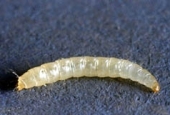The Norway rat, Rattus norvegicus, can be infested with large numbers of Northern and Oriental rat fleas. Infestations of these rats in and around the home may promote flea activity and require flea control as well as rodent control. In Alameda County few Roof rats, R. rattus, have been found infested with fleas.
As part of our disease surveillance program, our District collects fleas from wild rodents such as ground squirrels, wood rats, deer mice and voles. Flea species and numbers per animal indicate disease potential and risks for the general public.
The first step in flea control is to determine the source (flea host) of the fleas. In most cases the fleas are feeding on pets, cats or dogs. In some cases the fleas are feeding on wildlife such as raccoons or skunks living under the house or deck. In these cases the animal should be excluded from the structure and entry points sealed. In the case of pets there are various products to treat fleas on your pets. Consult a veterinarian for recommendations.
The next step is to eliminate the existing adult and larval fleas. It is recommended to hire a professional, licensed pest control operator to carry out treatment. Prior to any treatment, thorough and regular vacuuming is important. Pay close attention to areas where your pet sleeps, rests, or spends time including sofas and beds. Flea larvae hide in cracks, under cushions, pet bedding, and carpets. Laundering pet bedding, sofa covers, and bed coverings is advisable.
There are a number of pesticides on the market for flea control. There are commercially available flea traps or home-made traps can be utilized. Placing a shallow pan filled with detergent and water on the floor with a light source 6” above is also effective in trapping fleas. Using a combination of products is most effective. Monitor your pet for fleas on a regular basis to prevent an infestation.
If you are experiencing flea problems, call our office or submit an online request for service. Our District Biologist will inspect your property and adjacent properties, if necessary, to determine the flea species, the cause of the flea infestation and recommend control measures. Correct flea identification will help to determine the host animal and assist in recommending proper control measures.
Download the complete Brochure here








